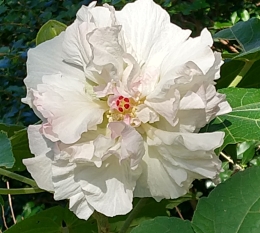A New Resident
By George Szabo
In March, my wife Jean brought home another orphan plant cutting, given to her by one of her fellow Master Gardeners.
Neither of us knew anything about this visitor called by its donor as “Hibiscus Mutabilis”. After a good deal of inquiry, we learned that this stranger was commonly called “Confederate Rose”. We have now lived with this adoptee for eight months, and expert to know a great deal more about this plant by next March. Based on what we have experienced so far, readers should put this plant on their Must Have List.
The Confederate Rose appeared as a twelve-inch cutting, about one half inch thick, wrapped in damp newspaper. It had been removed from the parent plant in the fall before first frost and had bathed in a container of water in a place that prevented it from freezing. After four weeks of immersion in water at our home, it had grown some promising roots, and so, it was now time for it to have a permanent residence. This location was a raised bed containing potting soil and top soil, in partial sunnext to a privacy fence.
It became obvious to us that this plant was going to be “Boss”. It grew quickly and confidently, and is now fourteen feet tall, and eight feet wide! I just measured its girth at the base (four inches) and measured one of the leaves, eight inches wide, and shaped like a sycamore leaf. No artist could match the green color of its leaves. On October 31st, I counted 42 blooms on its branches with probably another 100 ready to please the eye!
The blooms are large, and are colored a delicate light pink. The flowers last about three days, turning a deep pink before falling, hence, the description “Hibiscus Mutabilis”. Generally, “Rose” has an excellent balanced tree form, nice green foliage,tall and wide, so sturdy that is will not bend down, and is covered with many brilliant flowers. It blooms in October, is easily grown, and free of insects, except for the big black and yellow bees. They love this plant.
We are still learning about “Rose” and we have been told that cold weather will kill the branches, and that the entire growth should be removed exposing only an inch or so of the main stalk. We have been also told to cover the stub with mulch in the winter, and next spring the plant will repeat its previous performance. Cuttings should be taken from the branches before frost and freezing, placed in water that should be changed every two weeks, and then with new roots, planted in the Spring.
We are very happy with “Hibiscus Mutabilis” and of course refer to it by its common name “Confederate Rose”. It’s a can’t miss planting, easy to grow, beautiful, and a great conversation starter!
George Szabo, an intern in the 2017 Master Gardener Class, lives in Montgomery. For more information on becoming a master gardener, visit www.capcitymga.org or email capcitymga@gmail.com.
 Part of the Alabama Cooperative Extension Service (ACES)
Part of the Alabama Cooperative Extension Service (ACES)
